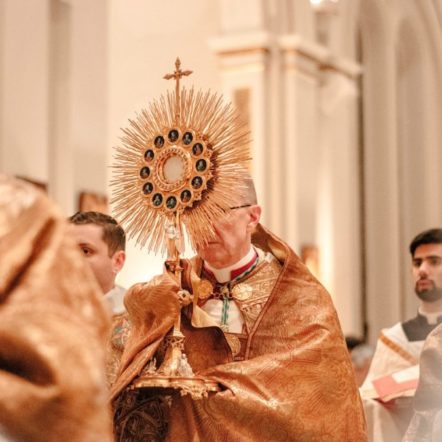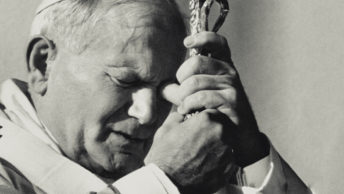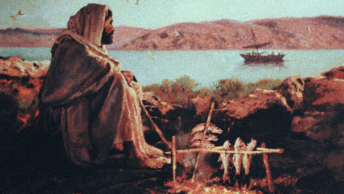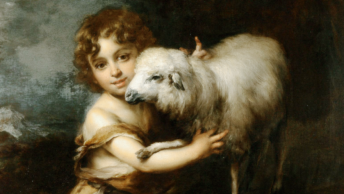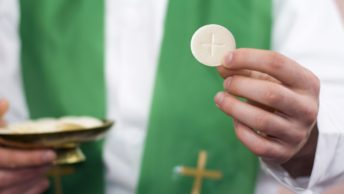According to some surveys and research polls, 70% of Catholics do not believe the Eucharist truly is Christ’s Body and Blood, and consider it only symbolic—even though the Real Presence of Jesus is clearly attested to in Scripture and has always been the teaching of the Church. Perhaps part of the problem is that the Church hasn’t done a good enough job of publicizing the many miracles of the Eucharist that have occurred throughout history. One of the most famous happened at the Italian town of Lanciano in the 8th century. A priest had doubts as to whether the Eucharist was in fact the Body and Blood of Christ; in response, at the moment of Consecration, the Host in his hands turned into actual human flesh, and the wine in the chalice became human blood. The flesh has been preserved to this very day, and scientific tests have shown that it is authentic human flesh from the tissue of the myocardium, or heart; the miraculous blood is authentic human blood, and type AB—the same blood type as that of the image of Christ on the Shroud of Turin, and the type most characteristic of persons from the Middle East (The Eucharistic Miracles of the World, Institute of St. Clement I, Pope and Martyr, p. 132).
Similar instances of the Host turning into human flesh occurred in Austria and elsewhere. Also, in the year 1330 a priest carelessly and irreverently stuck a Host in between pages of a prayer book. This Host was transformed into a clot of Blood which stained the pages of the book (p. 120). In Germany a pious but misguided farmer stole a Host for his own personal devotion. It accidentally fell on the ground, and no one was physically able to pick It up, including the parish priest. The local bishop was able to do so, but only after promising to build a chapel on the site (p. 81). In 1461 a boy who had been paralyzed and mute for five years as a result of an accident received Communion on Easter Sunday, and was completely healed and able to speak (p. 62). In Belgium some enemies of the Church stole several Hosts and pierced Them with knives as an act of hatred; they were terrified when from the Hosts came a flow of living Blood (p. 23). In 1572 Protestant soldiers in Holland plundered a Catholic church. One of them trampled a consecrated Host with a spiked boot, piercing It in three places; Blood immediately began to drip from the holes, and then took the form of three small wounds in a circle. That Host has been preserved, and these marks are still visible today (p. 202). Two non-believers in Italy received Holy Communion in 1604, but spat the Hosts on the stone floor of the Church. When a priest picked Them up, he saw that They left circular imprints on the stone, as if They had been carved into it (p. 138). In 1906 the small Colombian island of Tumaco was about to be wiped out by a tsunami. The parish priest led a procession with a Host in the monstrance, or sacred vessel, and with It traced the Sign of the Cross in the air at the water’s edge; the huge wall of water suddenly stopped and began receding, sparing the island (p. 35). A small chapel in France where Eucharistic Adoration was occurring was flooded by a river after days of heavy rain, but the water—almost six feet deep—parted to the right and left of the altar, like two walls, leaving the altar and monstrance completely dry (p. 49). Also, some of the saints lived for years at a time with no physical nourishment other than daily Holy Communion.
There are dozens, if not hundreds, of similar documented Eucharistic miracles; I’ll mention just one more. When Pope Francis was Archbishop of Buenos Aires, a Host which had fallen to the floor was placed in a vessel of water—but instead of dissolving, it showed several stains of Blood which grew in size each day. Scientific tests showed the Blood was from the myocardium—specifically, the left ventricle—of someone Who had suffered great physical trauma. A theologian commenting on this said, “the fact that it was really the myocardium was not by chance. . . . The Lord in this miracle wanted to show us His myocardium, which is the muscle that gives life to the whole heart, just as the Eucharist does with the Church. And why the left ventricle? Because from it comes the purified blood, and Jesus is the One Who purifies His Church from her sins” (p. 7). The Eucharist truly is a miracle, and so we must never disrespect It or take It for granted.
If Jesus, as the Son of God, is able to multiply five loaves and two fish into enough food to feed five thousand people, He can certainly change bread and wine into His Body and Blood—and as St. Paul tells us, each time we receive the Eucharist, we proclaim and share in Christ’s saving death—and so it will be until the end of the world.
I usually like to have our second graders write about their experiences when making their First Communion, and this year several of them mentioned their excitement and happiness on that day; one girl wrote, “I felt a little scared and a little happy.” A boy said, “I was a little nervous, but when I made First Communion I was fine.” A girl stated, “I feel pounding in my heart,” and a boy added, “I feel like Jesus is in me.” Two other boys said, “I felt holier,” and “Holy Communion was great—it was the best thing ever.”
The innocence and excitement conveyed by these and similar comments are not only refreshing, but also a reminder of the joy and gratitude we should feel for this Divine Gift—one only available in the Catholic Church. Many of the saints have witnessed or been the recipients of Eucharistic miracles, and several have even died rather than allow Christ’s Body to be desecrated or abused by the Church’s enemies. Many mystics have seen amazing visions of what happens at Mass, including multitudes of angels and saints bowing down in worship, souls from purgatory being cleansed by Christ’s Blood, and deceased loved ones of the persons present in church joining them in worship and prayer. When we die we will be amazed to learn of the miracles occurring in church that we so easily take for granted, and perhaps filled with regret if we have treated Holy Communion in a casual or indifferent manner. Worthily attending Mass is the closest we can come to the glory of Heaven while still on earth, and receiving Holy Communion in a state of grace is the most wonderful way of sharing in the very life of Jesus Christ, our Lord and God, Himself. We must set aside any doubts and any spirit of irreverence, and instead open our hearts to Jesus with all humility, faith, and gratitude—for in this way we will receive blessings and spiritual graces far beyond anything this world can give.

